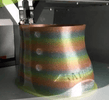
Revolutionizing Spinal Brace Fabrication with the Satres Helios Ortho
, by E-com Digit, 5 min reading time

, by E-com Digit, 5 min reading time
When it comes to producing spinal braces—or back braces—with precision, comfort, and customization, traditional methods like thermoforming or molding often fall short. Enter the Satres Helios Ortho, a 3D printer engineered to bring orthopedic device manufacturing into the future.
When it comes to producing spinal braces—or back braces—with precision, comfort, and customization, traditional methods like thermoforming or molding often fall short. Enter the Satres Helios Ortho, a 3D printer engineered to bring orthopedic device manufacturing into the future.
The Helios Ortho delivers exceptional resolution—down to 50 microns—ensuring intricate anatomical details and snug fits essential for spinal braces. Moreover, its generous build volume of 600 × 600 × 600 mm enables printing large-scale items such as cylindrical spinal support shells in one uninterrupted job.
This printer supports advanced materials like PEEK, Carbon-PA, Nylon, Ultem, and more—ideal for spinal braces requiring high mechanical strength, thermal resistance, and biocompatibility. This flexibility allows customizing stiffness, flexibility, and weight per patient needs.
Equipped with a heated build chamber up to 120 °C, Helios Ortho minimizes warping in high-performance plastics and enhances layer adhesion—critical for load-bearing braces.
Built-in filament drying and HEPA-grade CleanAIR filtration ensure safer, more consistent fabrication. Remote monitor-and-control via PC or smartphone provides real-time oversight and uninterrupted operation.
Spinal braces must follow a patient’s unique anatomy to prevent pressure points and promote comfort. The Helios Ortho’s ultra-fine resolution ensures that every curve and contour is properly mirrored—improving efficacy and patient satisfaction.
High-performance thermoplastics such as PEEK and Carbon-PA offer the load-bearing strength required of spinal braces while remaining lightweight. These materials also offer excellent fatigue resistance—important for long-term wear.
Thanks to the large build envelope, you can print an entire spinal brace or its main segments in a single build. This reduces assembly time, lowers manufacturing complexity, and speeds up delivery.
Features like power-failure recovery, combined with drying systems and remote control access, ensure large prints (common for spinal braces) can complete uninterrupted and consistently.
Helios Ortho offers freedom from proprietary filament ecosystems. You can select and qualify the best materials for each case—potentially reducing material costs and ensuring traceability for clinical compliance.
3D Scan or CAD Model Input
Use CT or 3D-scan data of the patient's torso to craft a digital model tailored to their shape and support requirements.
Material Selection
Choose an appropriate thermoplastic—Carbon-PA or PEEK for structural support, or Nylon blends for more flexible, lower-profile models.
Print Setup
Configure the print: enable heated chamber, filament drying, and CleanAIR system. Select fine layer height (~50 µm) in critical zones like vertebral contact areas; coarser resolution elsewhere for speed.
Printing
The printer executes the entire brace or its segments within its large build platform, with remote monitoring to manage long durations.
Post-Processing
Remove supports, optionally smooth surfaces, and inspect fit against the patient’s scan. Minor adjustments can be reprinted quickly thanks to the unmatched precision.
Fit and Feedback Loop
Patient fit evaluation—if zoning or stiffness tweaks are needed, re-slicing and reprinting is fast and repeatable.
Surface Finish: FDM surfaces are inherently layered. For comfort, consider adding a thin padded liner or using light post-processing such as vapor smoothing (material-dependent).
Weight: Despite high-strength polymers, internal lattice infills and hollowing strategies can reduce material usage and overall weight.
Regulatory Compliance: Using traceable, qualified resins and maintaining process control (as offered by Helios Ortho's environment systems) supports clinical device standards.
| Feature | Benefit for Spinal Braces |
|---|---|
| 50 µm precision | Anatomically accurate, pressure-free fit |
| 600 × 600 × 600 mm build volume | Single-print brace production without segmentation |
| High-temp compatible materials | Durable, lightweight, and clinically acceptable structures |
| Heated chamber, drying, HEPA | Reliable prints with high-quality material handling |
| Remote control, power recovery | Higher uptime, secure long-duration production |
The Satres Helios Ortho brings spinal brace fabrication from manual-labor-intensive and imprecise worksheets into digital manufacturing—offering unprecedented fit accuracy, material performance, production efficiency, and clinical-grade reliability. By harnessing this platform, orthopedic labs can elevate patient care, speed delivery times, and scale operations strategically.

Using both pressure mapping and 3D scanning is no longer optional—it is becoming the gold standard in modern clinical practice.

LiDAR vs. Structured-Light 3D Scanners in Orthotics & Prosthetics: What Clinicians Need to Know

In the fast-evolving landscape of digital fabrication for orthotic and prosthetic (O&P) device production, it’s tempting to assume that 3D printing is the inevitable future....